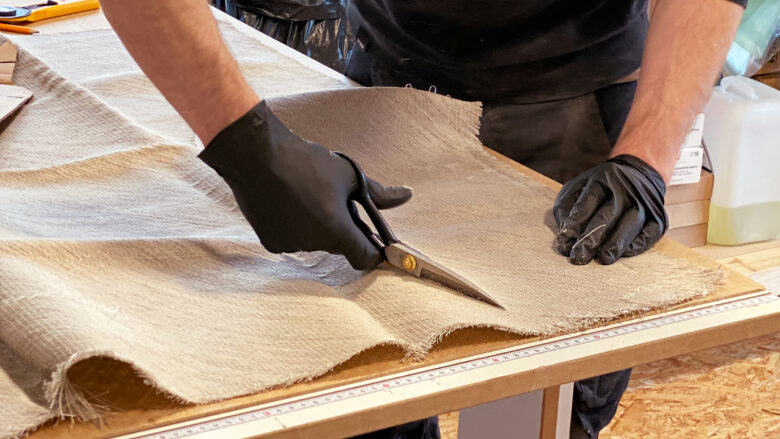Are natural fiber reinforced plastics worth it?
In October 2021, we presented the AquaSpeeder, which we had developed on behalf of a private investor, to the public. However, the project is far from over for us. Even at the beginning of the development phase, the idea to further optimize the due to its electric propeller drive already environmentally friendly AquaSpeeder had been on our minds.
The hull of the AquaSpeeder is built from fiberglass composite using a lightweight construction method — a process in which glass fibers are embedded in a matrix of epoxy resin. They then ensure that the forces that act on it are introduced into the component in a targeted manner. The result is a highly stable yet lightweight hull.
However, glass fibers have the disadvantage that they are neither renewable nor biodegradable — in contrast to natural fibers.
Are natural fibers the solution?
They are, in any case, an alternative that can and should be considered more closely.
As the name suggests, natural fibers are of both animal and plant origin, with the majority of plant fibers used in fiber composites being from plants such as flax, hemp, jute, kenaf, sisal and abaca.
Natural fiber reinforced plastics, or NFRP for short, have so far mainly been used in the automotive industry, e.g. for the interior paneling of doors. They offer high rigidity with low density. In short: they are extremely resilient and light at the same time.
Here's a small density comparison:
Steel — 7.9 g/cc.
Fiberglass — 2.7 g/cc.
Carbon Fiber — 1.8 g/cc.
Flax fiber — 1.4 g/cc.
Since hemp, flax and the like are renewable raw materials that — depending on the plant — can be grown on almost every continent, a constant supply could be guaranteed. They cause less CO2 during production and also bind CO2 from the atmosphere while the plant is growing. Natural fiber reinforced plastics offer good thermal and sound insulation. Up to 100% of the cutting waste that occurs in the processing can be reused.
In addition, resins are now available with 50% of the carbon content derived from plants, which in turn can save 50% of CO2 compared to conventional resins.
Even if you include the post-production processing steps, natural fiber composites have a carbon footprint that is around 50% lower than fiberglass composites.
So, what's the catch?
To put it simply: since flax fibers, for example, offer only one-fifth the tensile strength (force required to hold a weight against gravity) of, for example, carbon fibers and half the tensile strength of glass fibers, a component using flax fibers would need to weigh four times as much as an otherwise identical component made of carbon fibers in order to be equally effective. Same goes for flax fibers compared to glass fibers. Since fibers and resin are used in fiber composites in a 50/50 ratio, using more fibers also means using more resin. This not only worsens the ecological balance, but may even reverse it.
While the pure natural fiber remains CO2-neutral even when needing disposal, components made of fiber composites must be disposed of as special waste regardless of the fiber used due to their plastic content. This usually happens thermally.
Flax fibers (still) cost more than five times as much as glass fibres. Their properties are, on a basic level, similar to those of glass fibers, but cannot replace them one-to-one. In addition, it is a location-dependent natural product that requires particularly targeted quality management in order to cushion fluctuations caused by the climate.
As with so many things, cost matters. The know-how required for the cultivation of hemp, flax and the like is primarily used in the textile industry. Only a few manufacturers produce natural fibers for use in fiber composites. Their fibers are priced accordingly.
A preliminary conclusion
Applied to our example of the AquaSpeeder, the current prices for carbon, glass and natural fibers mean that an otherwise identical component that is made with flax fibers would cost six times as much as one made with glass fibers and would be 20% more expensive than one made with carbon fibers.
We are all aware that eco-friendly materials cost more. As product developers, however, we are confronted with the question of whether natural fibers are (already) worth it from an ecological and economic point of view.
Weight plays an important role in the construction of watercraft, which is why the use of natural fibers for structurally important components is currently not an option for us. But: more and more resins with biodegradable components are becoming available. It is conceivable to use bioresins in combination with natural fibers for structurally unstressed components such as panelling, upper shell and lid?
We would be happy to discuss this as well as to receive input regarding our thesis that, taking into account mutually influential factors such as density, weight, resin content and tensile strength, the use of natural fiber materials is not ecologically and economically worthwhile at the present time. Can you think of any use cases we missed in our considerations?

